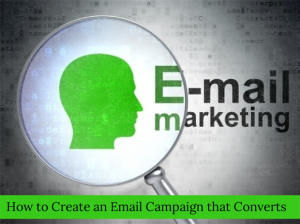
Have you started an email marketing campaign for your business yet? Are you worried you might spend hours at your computer trying to figure out what to write?
Email marketing campaigns are a great way to increase leads for small and medium sized businesses. Email campaigns have long been proven to be successful, which is why more and more businesses are trying them.
In order to create an email marketing campaign that converts leads into sales, you’ll have to include a few important elements. Are you ready to learn what these are?
Elements to Avoid
It’s important to understand what an email marketing campaign isn’t when discussing how to create campaigns that will successfully convert. Email marketing campaigns are not:
• Spam
• Free
• Easy
Email marketing campaigns are not designed for you to spam anybody and everybody with the same message. Proper campaigns are permission-based, which means that you need to get customers to supply you with their contact information or “opt-in” to an email list.
There is a cost associated with making sure that emails are well written, properly tested, expertly edited and tracked for the maximum amount of potential and success.
The Goals of Email Marketing Campaigns
If you’ve successfully executed your email marketing campaign, some key things should be happening next:
• Visitors should be coming to your website in larger numbers.
• You’re creating a general sense of brand awareness.
• Your audience is growing thanks to meaningful content.
• Conversions are being driven to your sales funnel.
• You’re creating a sense of urgency with your customers to explore even after they’ve purchased products.
If your email marketing campaigns do not see most or all of those results, it’s very likely that your campaign isn’t being executed to the best of its ability. People need to both take the time to read your email messages and act on them. Potential customers and even existing ones aren’t going to do that if your campaign isn’t grabbing their interest.
Step 1: Decide Who to Send Your Emails To
One of the most important things to figure out before your email campaign begins is your target audience. You need to think about the types of people that you’re trying to reach and the problem that your product can help them solve.
You should also research buying patterns, slow seasons, related demographics and more. When compiled together, all of this information will serve as your “buyer persona.” It will be a representation of the type of person who is most likely to spend money on what you have to offer.
Step 2: Use Action Language
Email marketing campaigns should guide your reader with action language without being obnoxious. Throughout your email messages you need to make sure that you:
• Tell the reader where to go to learn more.
• Tell the reader what they need to do to get what you’re offering.
• Give them contact information that they can use.
• Provide them Internet links for easy access to additional information.
• Let them know when they’re going to receive what you’re promising.
• Give them a deadline.
Giving a deadline is a great way to provide a sense of urgency to your message. Your readers better act fast before they find themselves left behind.
Step 3: Create Compelling Subject Lines
How many email messages do you wade through every day? A couple hundred? So do your email subscribers!
The first thing that your subscriber sees when they open their email inbox is the subject line. You need to make sure the subject line of your email message is attention grabbing and striking. Doing so will help make sure that the email stands out from the rest of the messages your customers are receiving and increase open rates.
There are two ways you can look at the practice of writing email subject lines: an unforgiving onslaught of repetition that drains your creativity OR an exciting and rewarding challenge [that] helps you become a better marketer and communicator. Alex Williams, Eloqua Blog
Step 4: Watch Trends
One of the biggest parts of staying on top of your target audience involves paying attention to trends. There are so many ways to get this information nowadays. Pick from several of these suggestions:
• Subscribe to email newsletters from industry peers and competitors.
• Read online and traditional magazines that cover topics relevant to your industry.
• Review relevant surveys.
• Participate in industry topic boards
• Read blogs that create content for your industry. Set up an application like Feedly to subscribe to multiple RSS feeds and read them from one place.
• Find and follow Twitter hashtags that focus on conversations your customers are having.
• Review Google Trends to see what other companies are doing.
• Visit top news sites like HuffingtonPost and scan for industry related topics.

Feedly RSS Reader Example
Step 5: Be Conversational
For the best results with email marketing campaigns, you should always try to be conversational and intimate. Don’t create a formal marketing campaign that reads like a form letter. Create messages that seem like they’re coming from a friend.
Step 6: Include a Strong Call to Action
The most important element of email marketing campaigns is the call to action. You need to tell your readers what you want them to do and where they need to go to do it. Whether it’s signing up for a newsletter, contacting you for more information about a one time offer or something else, always ask the reader to take further action.
Creating an email campaign is still one of the best ways to drive traffic to your website and get more leads. Pay attention to the steps above and you’ll be able to craft email marketing campaigns that create staggering results.
By Trent Dyrsmid
